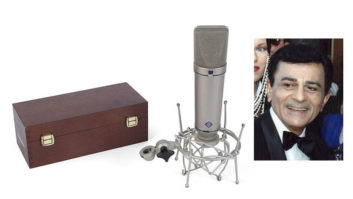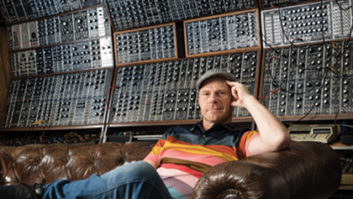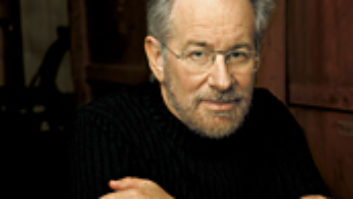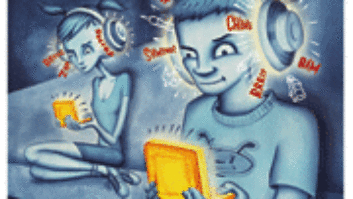Scooby Doo supervising sound editor Michael “Willy” Wilhoit seems like a pretty normal guy. Still, you have to figure that to work on this kind of wacky, everything-but-the-kitchen-sink soundtrack, a guy would have to be pretty wacky himself. And Wilhoit, on staff at Hollywood’s Liberty Livewire Soundelux since 1989, has plenty of experience in the genre. Although he counts among his credits diverse films including Natural Born Killers and Jerry Maguire, he honed his comedy chops by working on all three of the Home Alone films.
Also on the Home Alone series (picture editor on 1 and 2, director of 3) was Scooby‘s director Raja Gosnell. He and Wilhoit obviously clicked in the humor department. “We do have a similar style,” Wilhoit admits. “We like funny exaggeration, and we tend to use three things together to get that: real sound, a comedy effect and an enhanced ‘something.’”
Scooby 2002 combines live action for the humans with a digitally animated Scooby in a jam-packed plot as the cowardly, clue-sniffing Great Dane and his meddling pals are called upon (yet again!) to save the world. Sarah Michelle Geller and Freddie Prinze Jr. star as Daphne and heartthrob Fred Jones, with the rest of the regulars along for a ride to the strange and demon-filled Spooky Island, where a magical force has awakened that may make slaves of the human race. It’s a wild ride, and so was making the soundtrack.
“We’ve had visual effects coming in every day and changing every day for eight months,” laughs Wilhoit. “Usually in an animated film, you do dialog first and they animate to that. In this case, it’s been going back and forth. We’ve been rewriting jokes, trying to find the right balance between scary and funny. It’s been evolving the whole time.”
Wilhoit and his lead team, sound designer Scott Sanders and dialog supervisor Kelly Oxford, helped each other keep perspective through the sensory overload. “It’s as complicated as any action film, and in some ways, more difficult,” Wilhoit notes. “In an action picture, you see a plane, it has a certain sound. Or, you have a ’65 Mustang, so you have to find that car. But we have demons and caves and a fantasy island — it’s all imagination and all subjective. Half of the sounds for this picture had to be created. We’ve been combining comedy effects with sounds that we’ve recorded and sounds from Soundelux’s library, then twisting all of it around so that everything is new and specific to this film.
“We believe the sounds have a lot to do with whether a joke’s going to work or whether a scene’s going to get too scary, so we get very detailed. It’s been a process. We started out shying away from the classic Scooby Doo-style sounds, but we’ve slowly been introducing them and now we have a lot.”
An especially tricky bit involved a scene where the actors “soul swap.” “I had never come across that before!” Wilhoit exclaims. “Actors’ voices come out of other people’s mouths — Shaggy is Velma wearing a dress, etc. — and they all switch around two or three times. We decided that the actor whose voice it was going to be should say the line and also do the body movement, letting the actor who was actually going to do the body movement watch and mimic. Actors have unique cadences; in order to believe that Velma is now Daphne, she needs to speak at a different speed. We couldn’t just have one actor read the line, then have the other actor come in six months later and keep it believable.”
Also tricky were the demon vocalizations; the line was fine between scary and too scary, fun and too goofy. “We used elements of real animals and actors, and also of myself and our sound designers, because you can’t keep actors there all day doing stuff. We tried Tyrannosaurus Rex-like, and we tried ‘actor-like.’ Now, we’re using almost everything we come up with.”
The bulk of the sound editorial was cut at Soundelux’s Hollywood Boulevard studios, with work e-mailed to the picture editorial rooms and loaded into Avids for Gosnell to audition as he cut. “He needed the sounds to make some of the scenes work,” Wilhoit explains. “Especially for the demons and for Scrappy Rex, who grows up, gets big and bounces around. We would make sounds, the animators would sync to it, and we’d just keep refining and improving.”
Soundelux’s library was also available through its Internet server on the Warner Bros. stage, where mixers John Reitz, Greg Rudloff and Dave Campbell handled dubbing. “It’s the first show where we had full access to our library on the stage,” comments Wilhoit. “With Pro Tools and the sound servers, it’s amazing how we can do things on-the-fly. It’s been a great picture for sound because there’s so much to do. And, of course, we make ourselves laugh all the time.”





